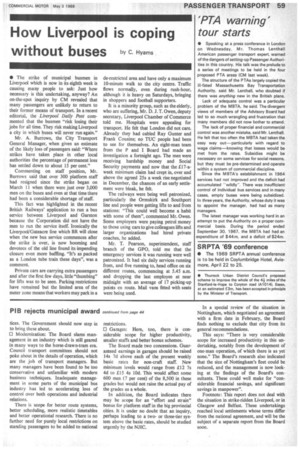How Liverpool is coping
Page 61

If you've noticed an error in this article please click here to report it so we can fix it.
without buses by C Hyams • The strike of municipal busmen in Liverpool which is now in its eighth week is causing many people to ask: Just how necessary is this undertaking, anyway? An on-the-spot inquiry by CM revealed that many passengers are unlikely to return to their former means of transport. In a recent editorial, the Liverpool Daily Post commented that the busmen "risk losing their jobs for all time. They risk making Liverpool a city in which buses will never run again."
Mr. A. Burrows, the City Transport General Manager, when given an estimate of the likely loss of passengers said: "Where strikes have taken place in other local authorities the percentage of permanent loss has settled down to about 15 per cent."
Commenting on staff position, Mr. Burrows said that over 300 platform staff had resigned since the strike began on March 11 when there were just over 3,000 men on the buses and even at that time there had been a considerable shortage of staff.
This fact was highlighted in the recent British Railways' application to run a bus service between Liverpool and Garston because the Corporation did not have the men to run the service itself. Ironically the LiverpooVGateacre line which BR will close when the new bus service commences after the strike is over, is now booming and devotees of the old line found its impending closure even more baffling. "It's as packed as a London tube train these days", was a comment.
Private cars are carrying extra passengers and after the first few days, little "thumbing" for lifts was to be seen. Parking restrictions have remained but the limited area of the meter zone means that workers may park in a de-restricted area and have only a maximum 10-minute walk to the city centre. Traffic flows normally, even during rush-hour, although it is heavy on Saturdays, bringing in shoppers and football supporters.
It is a minority group, such as the elderly, who are suffering, Mr. D. J. T. Owen, deputy secretary, Liverpool Chamber of Commerce told me. Hospitals were appealing for transport. He felt that London did not care. Already they had cabled Ray Gunter and Frank Cousins; no TUC people had been to see for themselves. An eight-man team from the P and I Board had made an investigation a fortnight ago. The men were receiving hardship money and Social Security payments and now that the £17-aweek minimum claim had crept in, over and above the agreed 25s a week rise negotiated in December, the chances of an early settlement were bleak, he felt.
The railways were being well patronized, particularly the Ormskirk and Southport line and people were getting lifts to and from stations: "This could well become a habit with some of them", commented Mr. Owen. Some employers were paying petrol money to those using cars to give colleagues lifts and larger organizations had hired private coaches, he added.
Mr. T. Pearson, superintendent, staff branch of the GPO, told me that the emergency services it was running were well patronized. It had six daily services running from, and five running to, head office on six different routes, commencing at 5.45 a.m. and dropping the last employee at near midnight with an average of 17 picking-up points en route. Mail vans fitted with seats were being used.




































































































































































































































